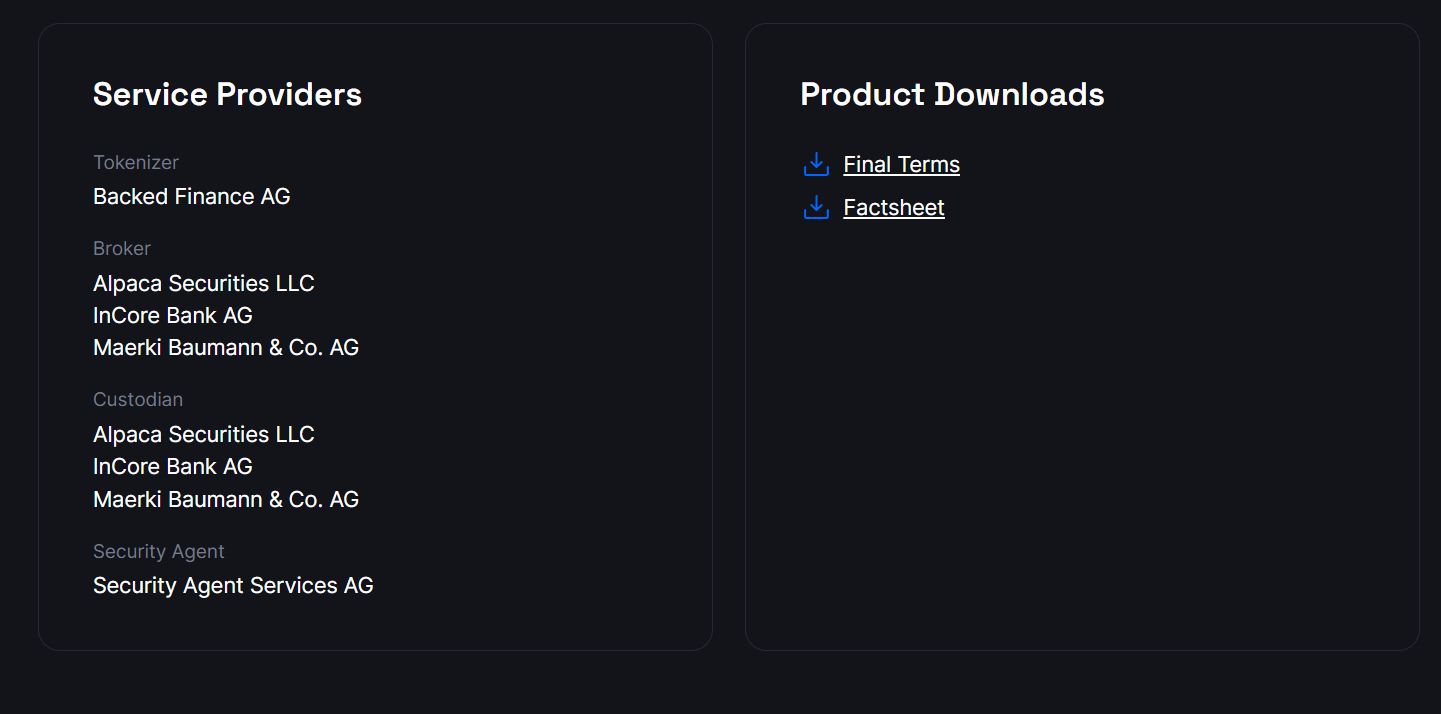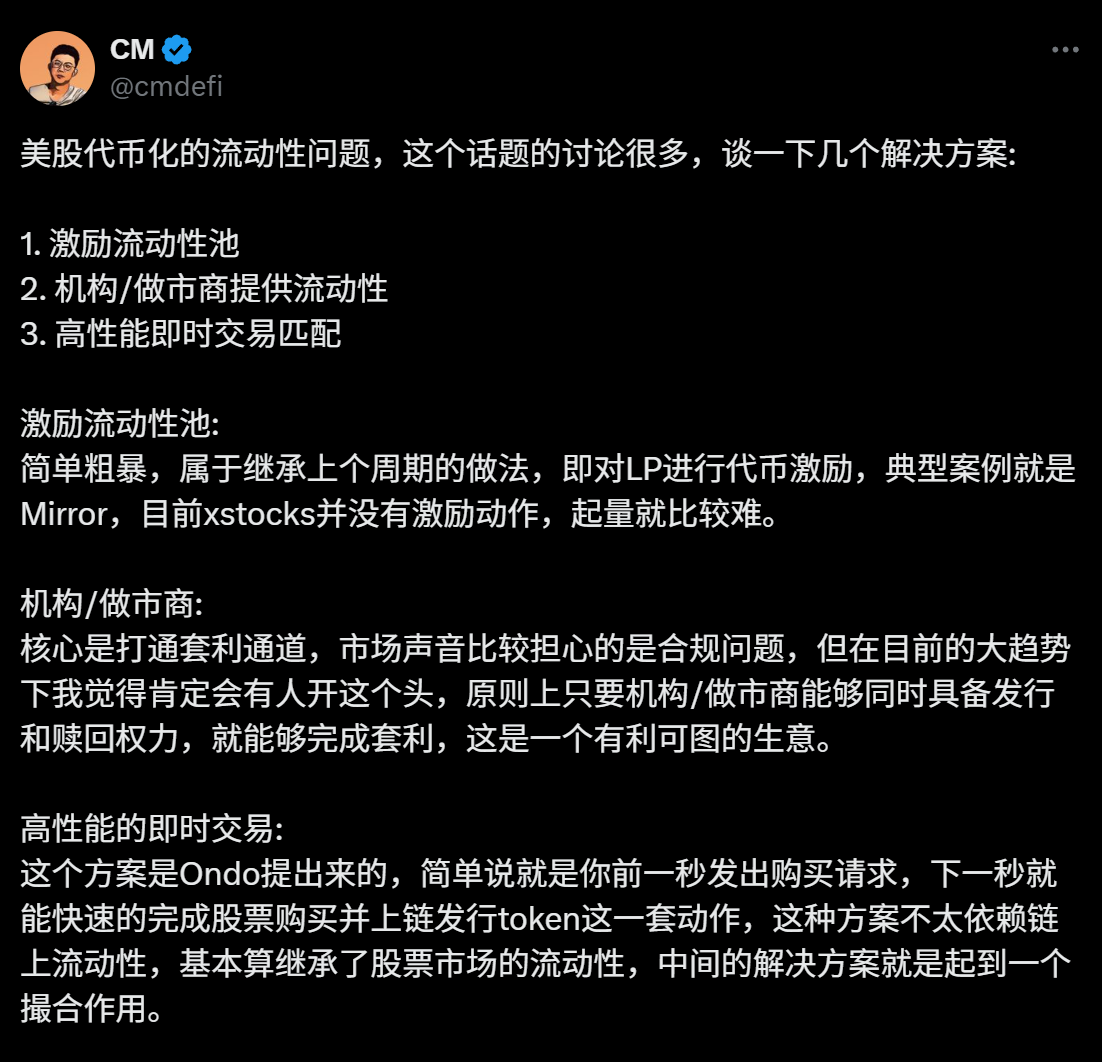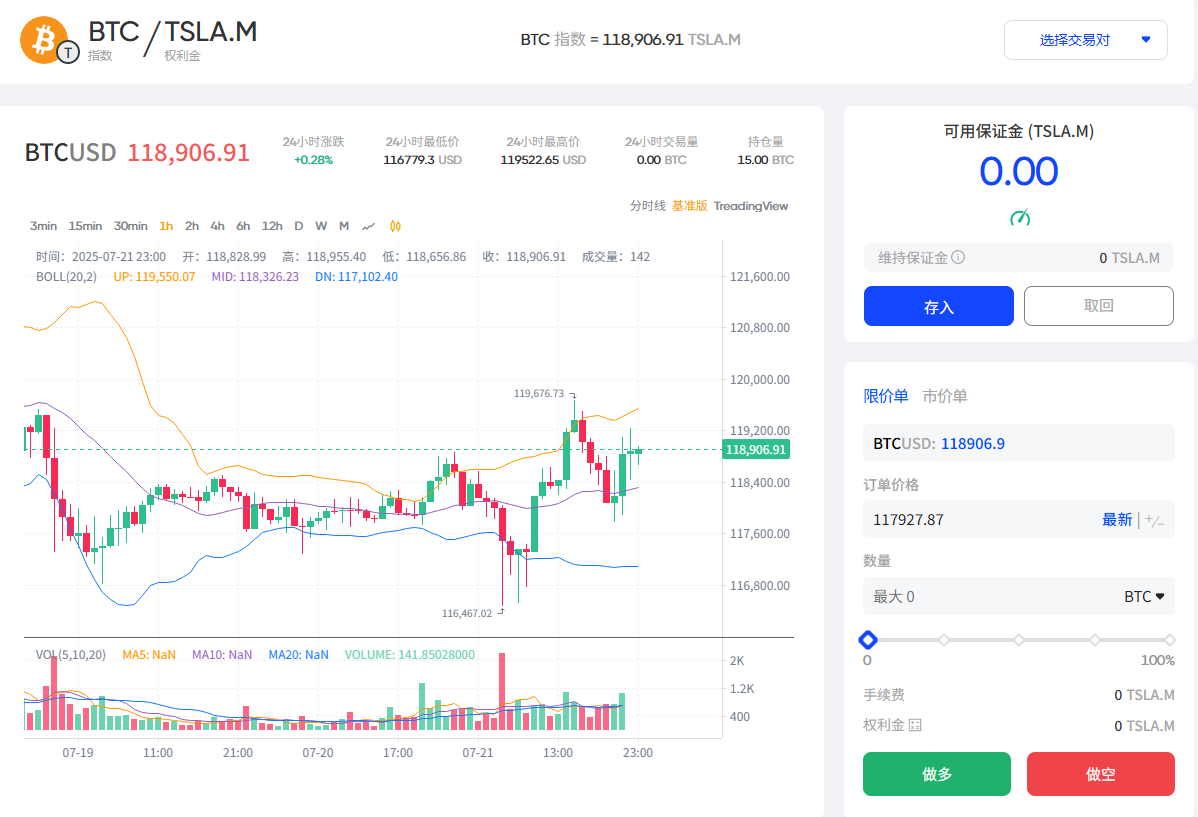Reflections on the Liquidity of Tokenized U.S. Stocks: How Should On-Chain Trading Logic Be Reconstructed?
Since the end of June, the Crypto industry has sparked a trend of "tokenizing U.S. stocks", with platforms like Robinhood and Kraken successively launching tokenized versions of U.S. stocks and ETF trading services, and even introducing high-leverage contract products for these tokens.
From MyStonks, Backed Finance (xStocks) to Robinhood Europe, all allow users to trade U.S. stock assets on-chain through the method of "real stock custody + token mapping"—theoretically, users only need a crypto wallet to trade Tesla or Apple stocks at 3 a.m., without opening a brokerage account or meeting capital thresholds.
However, with the rollout of related products, issues such as price manipulation, premiums, and de-pegging have frequently appeared in the news, quickly bringing the underlying liquidity problems to light: while users can buy these tokens, they can hardly short or hedge risks efficiently, let alone construct complex trading strategies.
Tokenizing U.S. stocks essentially remains in the initial stage of "only able to buy long".
1. The Liquidity Dilemma of "U.S. Stocks ≠ Trading Assets"
To understand the liquidity dilemma of this wave of "U.S. stock tokenization", it's first necessary to penetrate the underlying design logic of the current "real stock custody + mapping issuance" model.
This model is currently divided into two paths, with the core difference lying in whether it possesses compliant issuance qualifications:
One is the "third-party compliant issuance + multi-platform access" model represented by Backed Finance (xStocks) and MyStonks, where MyStonks collaborates with Fidelity to achieve a 1:1 peg to real stocks, and xStocks purchases and custodies stocks through Alpaca Securities LLC;
The other is the self-operated closed-loop of licensed brokers like Robinhood, relying on their own brokerage licenses to complete the entire process from stock purchase to on-chain token issuance;

The commonality of both paths is that they treat tokenized U.S. stocks as pure spot holding assets, where users can only buy and hold for appreciation, making them "dormant assets" lacking an expandable financial function layer, and difficult to support an active on-chain trading ecosystem.
Moreover, since each token must be backed by an actual custodied stock, on-chain trading is merely a transfer of token ownership and cannot affect the spot price of U.S. stocks, naturally leading to the "two skins" problem between on-chain and off-chain, where even small-scale buying and selling funds can cause severe price deviations on-chain.
For example, on July 3, the on-chain AMZNX (Amazon stock token) was pushed up to $23,781 by a $500 buy order, a premium of over 100 times the actual stock price. Even in non-extreme scenarios, most tokens (like AAPLX) often experience quote deviations and frequent price manipulation, becoming ideal scenarios for arbitrageurs and liquidity market-making teams to set up.

Secondly, the asset function of current U.S. stock assets is severely castrated. Even though some platforms (like MyStonks) attempt to distribute dividends through airdrops, most platforms do not open voting rights and re-staking channels, essentially just "on-chain holding certificates", not real trading assets, without "collateral properties".
For example, after users buy AAPLX, AMZNX, TSLA.M, CRCL.M, they cannot use them for collateralized loans, nor as margin to trade other assets, let alone integrate with other DeFi protocols (like using U.S. stock tokens for collateralized loans) to further obtain liquidity, resulting in nearly zero asset utilization.
Objectively speaking, the failures of projects like Mirror and Synthetix in the last cycle have proven that mere price mapping is far from enough. When tokenized U.S. stocks cannot be used as margin to activate liquidity scenarios or integrate into the trading network of the crypto ecosystem, no matter how compliant the issuance or how perfect the custody, it only provides a token shell, with extremely limited practical value under the background of liquidity scarcity.
From this perspective, current "tokenized U.S. stocks" only manage to bring prices on-chain, still stuck in the initial stage of digital certificates, and have not yet become real "financial assets available for trading" to release liquidity, making it difficult to attract a broader range of professional traders and high-frequency funds.
Therefore, for tokenized U.S. stocks, it is urgent to deepen their on-chain liquidity, provide holders with more practical application scenarios and holding value, and attract more professional funds to enter.
Currently, among the various mainstream solutions discussed by the market, besides the Web3 common "incentives to attract liquidity" model, there is an attempt to open up "on-chain - off-chain" arbitrage channels, improving liquidity depth by optimizing the efficiency of arbitrage paths.

1. Incentivized Liquidity Pools (e.g., Mirror)
The "incentivized pool model" represented by Mirror Protocol was once the mainstream attempt in the last cycle of tokenized U.S. stocks. Its logic is to reward users who provide liquidity for trading pairs by issuing platform tokens (like MIR), trying to attract funds with subsidies.
But this model has a fatal flaw, namely that incentives rely on token inflation and cannot form a sustainable trading ecosystem. After all, the core motivation for users to participate in liquidity mining is to obtain subsidy tokens, not real trading demand. Once the incentive intensity weakens, funds will quickly withdraw, leading to a cliff-like drop in liquidity.
More critically, this model never thought about "letting tokenized U.S. stocks generate liquidity themselves"— the tokenized U.S. stocks deposited by users are only part of the trading pair and cannot be used for other scenarios, the assets still dormant.
2. Market Maker-Led Liquidity (e.g., Backed / xStocks)
The "market maker-led model" adopted by Backed Finance (xStocks), MyStonks, etc., attempts to open up on-chain - off-chain arbitrage through compliant channels. Taking xStocks as an example, it purchases corresponding stocks through Interactive Brokers, and market makers can eliminate price differences by "redeeming tokens → selling stocks" or "buying stocks → minting tokens" when the on-chain token price deviates from the spot price.
But the implementation cost of this logic is extremely high. The complexity of compliance processes, cross-market settlements, and asset custody often consumes the arbitrage window with time costs. For example, Interactive Brokers' redemption process requires T+N settlement, and custodians' asset transfers often have delays. When on-chain prices show premiums, market makers often give up intervention due to inability to hedge in time.
Under this model, tokenized U.S. stocks are always "targets for arbitrage", not assets that can actively participate in trading, resulting in most trading pairs of xStocks having low daily trading volumes, with price de-pegging becoming the norm.
This is also the core reason why AMZNX could show a 100x premium in July but no one arbitraged.
3. High-Speed Off-Chain Matching + On-Chain Mapping
The "off-chain matching + on-chain mapping" model explored by Ondo Finance is actually similar to the PFOF (Payment for Order Flow) model already adopted by Mystonks, by completing the core trading process in a centralized engine and only recording the results on-chain, theoretically able to connect with the depth of U.S. stock spot markets.
But this model has high technical and process thresholds, and the traditional U.S. stock trading hours also need to match the 7×24-hour trading nature of on-chain.
These three liquidity solutions each have their merits, but whether it's incentivized pools, market makers, or off-chain matching, they all default to using external forces to "inject" liquidity, rather than letting tokenized U.S. stocks themselves "generate" liquidity. But to be honest, relying solely on on-chain - off-chain arbitrage or incentive subsidies is hard to fill the continuously growing liquidity gap.
Is it possible to jump out of the traditional arbitrage framework of "on-chain - off-chain" and directly build a trading closed-loop in the native on-chain environment?
In the traditional U.S. stock market, the reason liquidity is abundant is not due to the spot itself, but the trading depth constructed by derivative systems like options and futures—these tools support the three core mechanisms of price discovery, risk management, and capital leverage.
They not only improve capital efficiency but also create long-short games, non-linear pricing, and diversified strategies, attracting market makers, high-frequency funds, and institutions to continuously enter, ultimately forming a positive cycle of "active trading → deeper market → more users".
And the current tokenized U.S. stock market precisely lacks this layer of structure, after all, tokens like TSLA.M, AMZNX can be held but cannot be "used", neither for collateralized loans nor as margin to trade other assets, let alone constructing cross-market strategies.
This is very similar to ETH before DeFi Summer, when it couldn't be lent out, used as collateral, or participate in DeFi, until protocols like Aave endowed it with functions like "collateralized lending", releasing trillions in liquidity, and for tokenized U.S. stocks to break through the dilemma, they must replicate this logic, turning dormant tokens into "collateralizable, tradable, combinable living assets".
If users can use TSLA.M to short BTC, or use AMZNX to bet on ETH trends, then these dormant assets are no longer just "token shells", but margin assets being used, liquidity will naturally grow from these real trading demands.

Tokenized U.S. stock product service providers are indeed exploring this path. This month, MyStonks partnered with Fufuture to launch the Tesla stock token TSLA.M/BTC index trading pair on the Base chain, with the core mechanism being "coin-based perpetual options", truly making tokenized U.S. stocks "margin assets available for trading".
For example, allowing users to use TSLA.M as margin to participate in BTC/ETH perpetual options trading. It's reported that Fufuture plans to expand support for over 200 types of tokenized U.S. stocks as margin assets, so users holding small-cap tokenized U.S. stocks can use them as margin to bet on BTC/ETH rises and falls (like using CRCL.M as collateral for a BTC long position), thereby injecting real trading demand into them.
Moreover, compared to the centralized contract restrictions of CEXs, on-chain options can more freely combine strategies like "TSLA × BTC", "NVDA × ETH".
When users can use TSLA.M, NVDA.M as margin to participate in BTC, ETH perpetual options strategies, trading demand will naturally attract market makers, high-frequency traders, arbitrageurs to enter, forming a positive cycle of "active trading → deeper market → more users".
Interestingly, Fufuture's "coin-based perpetual options" mechanism is not only a trading structure but also naturally possesses the market-making ability to activate the value of tokenized U.S. stocks, especially in the current early stage where a deep market has not yet formed, it can directly be used as an OTC market-making and liquidity guidance tool.
Among them, the project can inject tokenized U.S. stocks like TSLA.M, NVDA.M as initial seed assets into the liquidity pool, building a "main pool + insurance pool". On this basis, holders can also deposit their tokenized U.S. stocks into the liquidity pool, bear part of the seller's risk, and earn the premiums paid by trading users, equivalent to constructing a new "coin-based appreciation path".

For example, suppose a user is long-term bullish on Tesla stock and has already bought TSLA.M on-chain. In the traditional path, his choices are only:
Continue holding, waiting for appreciation;
Or trade out on CEX/DEX;
But now he can have more plays:
Be a seller to earn premiums: Deposit TSLA.M into the liquidity pool, waiting for appreciation while earning premium income;
Be a buyer to release liquidity: Use TSLA.M as margin to participate in cross-asset options trading of BTC, ETH, betting on crypto market volatility;
Combination strategies: Part of the holdings for market-making, another part for trading, achieving two-way income paths, improving asset utilization efficiency;
Under this mechanism, tokenized U.S. stocks are no longer isolated assets but truly integrated into the on-chain trading ecosystem, being reused, opening up the complete path of "asset issuance → liquidity construction → derivative trading closed-loop".
Of course, different paths are still in the exploration stage, and this article only discusses one possibility.
This round of real stock custody models from MyStonks, Backed Finance (xStocks) to Robinhood Europe means that tokenized U.S. stocks have completely solved the initial problem of "whether they can be issued".
But it also indicates that the competition in the new cycle has actually come to the stage of "whether they can be used"—how to form real trading demand? How to attract strategy construction and fund reuse? How to make U.S. stock assets truly alive on-chain?
And this no longer relies on more brokers entering the game, but on the improvement of on-chain product structures—only when users can freely go long or short, construct risk combinations, and combine cross-asset positions, will "tokenized U.S. stocks" have complete financial vitality.
Objectively speaking, the essence of liquidity is not the accumulation of funds, but the matching of demand, when on-chain can freely achieve "using TSLA options to hedge BTC volatility", the liquidity dilemma of tokenized U.S. stocks may be easily resolved.
